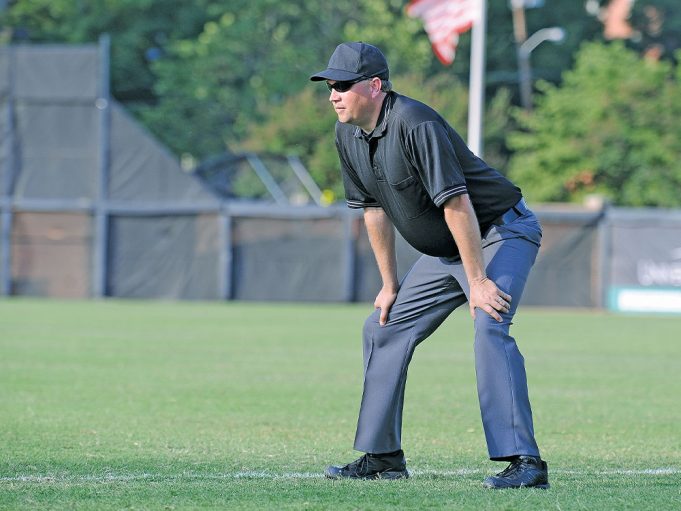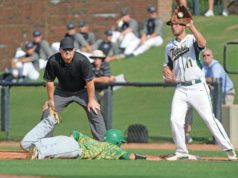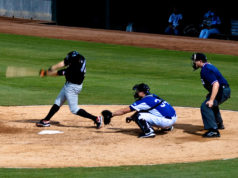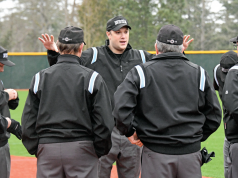Does your association have “good umpires”? Certainly it does. But are there a few umpires acknowledged to be better than the rest of the “good umpires?” Why is this so? It results to some degree from the better umpires doing more and seeing more during their time on the field. One way to enhance your positioning decisions and place yourself for better calls is to prepare for duties in the A position even before the game starts and half-innings begin.
OK, you jogged out to your position on the edge of the outfield grass. You notice the catcher calling for a throw down to second base and take that as your cue to jog quickly to the A position. You look up and see the plate umpire step out from behind the plate and point at you for final confirmation that you are ready. As you point back at him to confirm that you are ready, are you really as ready as you can be?
How many times have you found yourself waiting for pregame actions to be completed so the plate umpire can begin the game? Ideally you jogged from the home-plate meeting along the baseline past first base, then turned to a position at the outfield grass equidistant from both first base and second base. You stand there as you wait for the plate umpire to signal the last warmup pitch or the catcher to announce he will throw to second. Then you jog briskly to take up your position next to the baseline 10 to 12 feet behind the first baseman. This process takes a couple of minutes. You can and should use this time to improve your positioning and anticipation for calls.
Consider making the following a habit:
1) Introduce yourself to the batting team base coach, if he is already present. Just a simple exchange of names in a cordial manner will do. Knowing his first name is essential to the communication process when you have to quell dissent on a call, i.e., “No, Ken, he got him on the arm.” Be sure to introduce yourself to both team base coaches in the same manner. Keep it short, but be sure to do it.
2) Observe the playing area boundaries whether or not you are familiar with the field. Open dugouts, open or ill-fitting gates, gaps in fencing, the odd concrete post here and there and water drains all appear on baseball fields in foul territory behind first base. Make a mental note about how they can impact an overthrow. Are there obstacles in the line of an overthrown ball? Recognize trees or wires overhanging the field down the right-field boundary and prepare yourself to act accordingly. Situations with balls heading their way should have been covered in the pregame plate meeting, but be sure to recognize them from the A position before play begins. Check the gates as half-innings are getting ready to begin and remind bench personnel to close them.
3) Observe the area around your position. Is there a crown or bump along the baseline? Many groundskeeper-challenged high school fields have uneven surfaces along the right-field line behind first base. The last thing you need is to trip or stumble on uneven ground as you move into the infield or pivot to go out on a trouble fly ball.
4) Scan the dugout areas. Be alert for equipment or bats not stored within the confines of the dugout. Remind the appropriate coach to collect the stray team gear so the game isn’t unnecessarily delayed. Be sure to get players and extra team attendants in the dugout well before play can begin.
5) Scan along the boundary fence for baseballs on the playing field. Some balls may not be picked up after infield practice or before-inning warmups — some could even remain from a previous practice or game. Look for them and get them off the field. You should also scan for pieces of trash that might resemble a ball in the grass. Direct that these be picked up, too.
6) Observe infielder throws during warmups. You will probably get a couple of chances to observe second base, shortstop and third base throws. A third baseman whose practice throws consistently take the first baseman into the running lane on the home-plate side is likely to make a similar throw on a play in the upcoming innings. Watch for it and make a mental note. You can prepare yourself for a shift in positioniong to account for this offline throw, which may prompt a swipe tag or collision.
7) Track the infielder warmup throws into the first baseman. You probably have about six throws to observe his fielding skill and what he seems likely to do on a low throw. Is he proficient at digging out low throws or is every bounced throw getting by him? Knowing his tendencies makes your read-and-react process quicker if the ball is snagged or if it trickles by him to the boundary fence. Repeat this process when a substitute fielder enters at first base.
8) Keep observing the infield warmups during the game for offline-throw clues, especially when substitutions put a new player at second base, shortstop or third base.
Now, again, you see the plate umpire step out from behind the plate and point to you for final confirmation that you are ready. If you have taken care of business to get yourself ready for A position, when you point back to confirm that you are ready, you really are as ready as you can be!
What's Your Call? Leave a Comment:
Note: This article is archival in nature. Rules, interpretations, mechanics, philosophies and other information may or may not be correct for the current year.
This article is the copyright of ©Referee Enterprises, Inc., and may not be republished in whole or in part online, in print or in any capacity without expressed written permission from Referee. The article is made available for educational use by individuals.


















